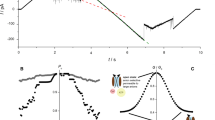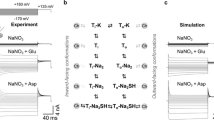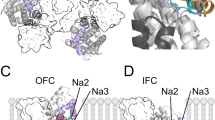Abstract
The voltage-dependent anion channel (VDAC), also known as mitochondrial porin, is a large channel permeable to anions, cations, ATP, and other metabolites. VDAC was purified from sheep brain synaptosomes or rat liver mitochondria using a reactive red-agarose column, in addition to the hydroxyapatitate column. The red-agarose column allowed further purification (over 98%), concentration of the protein over ten-fold, decreasing Triton X-100 concentration, and/or replacing Triton X-100 with other detergents, such as Nonidet P-40 or octylglucoside. This purified VDAC reconstituted into planar-lipid bilayer, had a unitary maximal conductance of 3.7 ± 0.1 nS in 1 M NaCl, at 10 mV and was permeable to both large cations and anions. In the maximal conducting state, the permeability ratios for Na+, acetylcholine+, dopamine,+ and glutamate−, relative to Cl−, were estimated to be 0.73, 0.6, 0.44, and 0.4, respectively. In contrast, in the subconducting state, glutamate− was impermeable, while the relative permeability to acetylcholine+ increased and to dopamine+ remained unchanged. At the high concentrations (0.1–0.5 M) used in the permeability experiments, glutamate eliminated the bell shape of the voltage dependence of VDAC channel conductance. Glutamate at concentrations of 1 to 20 mM, in the presence of 1 M NaCl, was found to modulate the VDAC channel activity. In single-channel experiments, at low voltages (±10 mV), glutamate induced rapid fluctuations of the channel between the fully open state and long-lived low-conducting states or short-lived closed state. Glutamate modification of the channel activity, at low voltages, is dependent on voltage, requiring short-time (20–60 sec) exposure of the channel to high membrane potentials. The effect of glutamate is specific, since it was observed in the presence of 1 M NaCl and it was not obtained with aspartate or GABA. These results suggest that VDAC possesses a specific glutamate-binding site that modulates its activity.
Similar content being viewed by others
REFERENCES
Benz, R. (1994). Biochim. Biophys. Acta 1197, 167-196.
Benz, R., Kottke, M., and Brdiczka, D. (1990). Biochim.Biophys. Acta 1022, 311-318.
Babel, D., Walter, G., Gotz, H., Thinnes, E P., Jurgens, L., Konig, U., and Hilschmann, N. (1991). Biol. Chem. Hoppe-Seyler 372, 1027-1034.
Basford, R. E. (1967). Methods Enzymol. 10, 96-101.
Bathori, G., Parolini G., Tombola, I., Szabo, F, Messina, I., Oliva, A., De Pinto, M., Lisanti, V., Sargiacomo M., and Zoratti, M. (1999). J. BioI. Chem. 274, 29607-29612.
Blachly-Dyson, E., Peng, S., Colombini, M. and Forte, M. (1990). Science, 247, 1233-1236.
Colombini, M. (1994). Current Topics Membr. 42, 73-101.
Colombini, M., Yeung, C L., Tung, J., and Koeing, T. (1987). Biochim. Biophys. Acta 905, 279-286.
de Pinto, V., Prezioso, G., and Palmieri, E (1987). Biochim. Biophys. Acta 905, 499-502.
Dermietzel, R., Hwang, T. K., Buettner, R., Hofer, A., Dotzler, E., Kremer, M., Deutzmann, R., Thinnes, E P., Fishman, G., Spray, D., and Siemen, D. (1994). Proc. Natl. Acad. Sci. USA 91, 499-503.
Floker, H., Thinnes, E P., Winkelbach, H., Stadtmuller, U., Paetzold, G., Morys-Wortmann, C, Hess, D., Sternbach, H., Zimmermann, B., Kaufmann-Kolle, P., Heiden, M., Karabions, A., Reymann, S., Lalk, V. E., and Hilschmann, N. (1994). Biol. Chem. Hoppe-Seyler 375, 513-520.
Gincel, D., Zaid, H., and Shoshan-Barmatz, V. (2000). J. BioI. Chem., manuscript submitted.
Guibert, B., Dermietzel, R., and Sieman, D. (1998). Intern. J. Biochem. Cell. Biol. 30, 379-391.
Guo, X. W. and Mannella, CA. (1993). Biophys. J. 64, 545-549.
Hodge, T. and Colombini, M. (1997). J. Membr. Biol. 157 , 271-279.
Holden, M. J. and Colombini, M. (1993). Biochim. Biophys. Acta 1144, 396-402.
Horn, A., Reymann, S., and Thinnes, F. P. (1998). Mol. Genet. Metab. 63, 239-242.
Huntter, W. B., Schiebler, W., Greengard, P., and de Camilli, P. (1983). Cell. Biol. 96, 1374-1388.
Kaplan, R. S. and Pedersen, P. L. (1985). Anal. Biochem. 150 , 97-104.
Krasitnikov, O. V., Carneiro, C. M. M., Yuldasheva, L. N., Camposde-Carvalho, A. C., and Nogueira, R. A., (1996). Brazil. J. Med. Biol. Res. 29, 1691-1697.
Laemmli, U. K. (1970). Nature London 227, 680-685.
Lee, A., Zizi, M., and Colombini, M. (1994). J. Biol. Chem. 269, 30974-30980.
Lowry, O. H., Rosenbrough, N. J., Farr, A. L., and Randall, R. J. (1951). J. Biol. Chem. 193, 265-275.
Luo, X., Budihardjo, I., Zou, H., Slaughter, C., and Wang, X. (1998). Cell 94, 481-490.
Mangan, P. S. and Columbini, M. (1987). Proc. Natl. Acad. Sci. USA 84, 4896-4900.
Mannella, C. A. (1997). J. Bioenerg. Biomembr. 29, 525-531.
Mannella, C. A., Forte, M., and Colombini, M. (1992). J. Bioenerg. Biomembr. 24, 7-19.
Reymann, S., Flarke, H., Heiden, M., Jakob, C., Stadtmuller, U., Steinacker, P., Lalk, V. E., Pardowitz, I., and Thinnes, F. R. (1995). Biochem. Mol. Med. 54
Reumann, S., Maier, E., Heldt, H. W., and Benz, R. (1998). Eur. J. Biochem. 251, 359-366.
Rostovtsera, T. and Bezrukov, S. M. (1998). Biophys. J. 74 , 2365-2373.
Rostovtseva, T. and Colombini, M. (1996). Biophys. J. 72 , 1954-1962.
Rostovtseva, T. and Colombini, M. (1997). J. BioI. Chem. 271 , 28006-28008.
Shafir, I., Feng, W., and Shoshan-Barmatz, V. (1998a). Eur. J.Biochem. 253, 627-636.
Shafir, I., Feng, W., and Shoshan-Barmatz, V. (1998b). J. Bioenerg. Biomembr. 30, 499-510.
Shoshan-Barmatz, V., Hadad, N., Feng, W., Shafir, I., Orr, I., Varsanyi, M., and Heitmeyer, M. G. (1996). FEBS Lett. 386, 205-210.
Siadat, S., Reymann, S., Horn, A., and Thinnes, F. P. (1998). Mol. Genet. Metab. 65, 246-249.
Towbin, H., Staehelin, T., and Gordon, J. (1979). Proc. Natl. Acad. Sci. USA 76, 4350-4354.
Zizi, M., Forte, M., Blachly-Dyson, E., and Colombini, M. (1994). J. BioI. Chem. 269, 1614-1616.
Zizi, M., Byrd, C., Boxus, R., and Colombini, M. (1998). Biophys. J. 75, 704-713.
Author information
Authors and Affiliations
Rights and permissions
About this article
Cite this article
Gincel, D., Silberberg, S.D. & Shoshan-Barmatz, V. Modulation of the Voltage-Dependent Anion Channel (VDAC) by Glutamate1. J Bioenerg Biomembr 32, 571–583 (2000). https://doi.org/10.1023/A:1005670527340
Issue Date:
DOI: https://doi.org/10.1023/A:1005670527340




